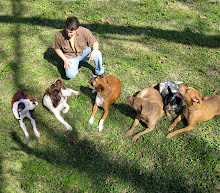
Whether your training your dog in the Houston summer heat or just enjoying a play session with your new puppy, overheating can happen quick. Our dogs eliminate heat through panting and through the bottoms of their feet. While drinking water can satisfy the dogs need for thirst, it does little to truly cool them down like most owners think.
Controlling your dogs level activity is first and foremost in preventing this. Letting your young, adolescent dog run wild continuously with out care, is a big mistake. While dogs do require physical exercise, it is the mental drive for work that pushes the dog physically. When dogs are not stimulated enough mentally, they explode with physical output when given the opportunity. Proper dog training addresses this through obedience exercises which stimulate and teach self control. Exhaust the dog mentally, you will slow them down to a normal level of activity physically. Once the dog has been trained, they are almost completely able to slow them selves down and rest before this happens. If your dog has not developed any self control or is not demonstrating any, a trained dog can be instructed to settle down and rest, get a drink and cool off before resuming play or being finished with physical activity all together.
Heat stroke happens when heat gain exceeds the body's ability to dissipate heat. High temperatures cause chemical reactions that break down body cells which lead to dehydration and blood thickening. This puts extreme strain on the heart and causes blood clotting and subsequent death to tissue. Liver, brain and intestinal cells are usually the first to be affected and this can occur quickly. Normal body temperature for a dog is about 101 F to 102 F. If his temperature reaches 106 F, he is in danger of brain damage, vital organ failure and death. Reducing body temp quickly is imperative. A dog who recovers can still have organ damage and lifelong health problems. Temperatures above 106 F are extremely dangerous.
All dogs handle heat differently, you are supposed to be the one who knows what's in your dogs best interest, not always them. An hour outside running around is more than plenty for most dogs. Many dogs, especially puppies and senior dogs, will overheat much quicker so pay attention to some key signs.
SymptomsRapid, frantic panting
Wide eyes
Thick saliva
Bright red tongue
Vomiting
Staggering
Plenty of cool drinking water and even a way to get the feet wet while outside adds additional cooling benefits. Never try to ice a dog down, it's too extreme and can cause further issues. And when in doubt, stop the physical activity and get the dog into the AC. This will allow you and your dog to play another day and stay mentally and physically healthy along the way.
Remember, proper obedience training helps keep your dog healthy, safe and alive by creating dependable responsiveness under distraction. If your obedience course didn't provide this, they didn't do their job. Your family dog needs to be just as reliable if not more than any working dog for the simple fact that they are required to be dependable in a variety of circumstances all the time, not just some.
It's not more than what you need, it's just more than your used to.
The Thinking Dog Training System
Read more at Suite101: Dogs and Heat Stroke: Understanding the Risks of Overheating http://dogs.suite101.com/article.cfm/dogs_and_heat_stroke#ixzz0rt0i2QBi




